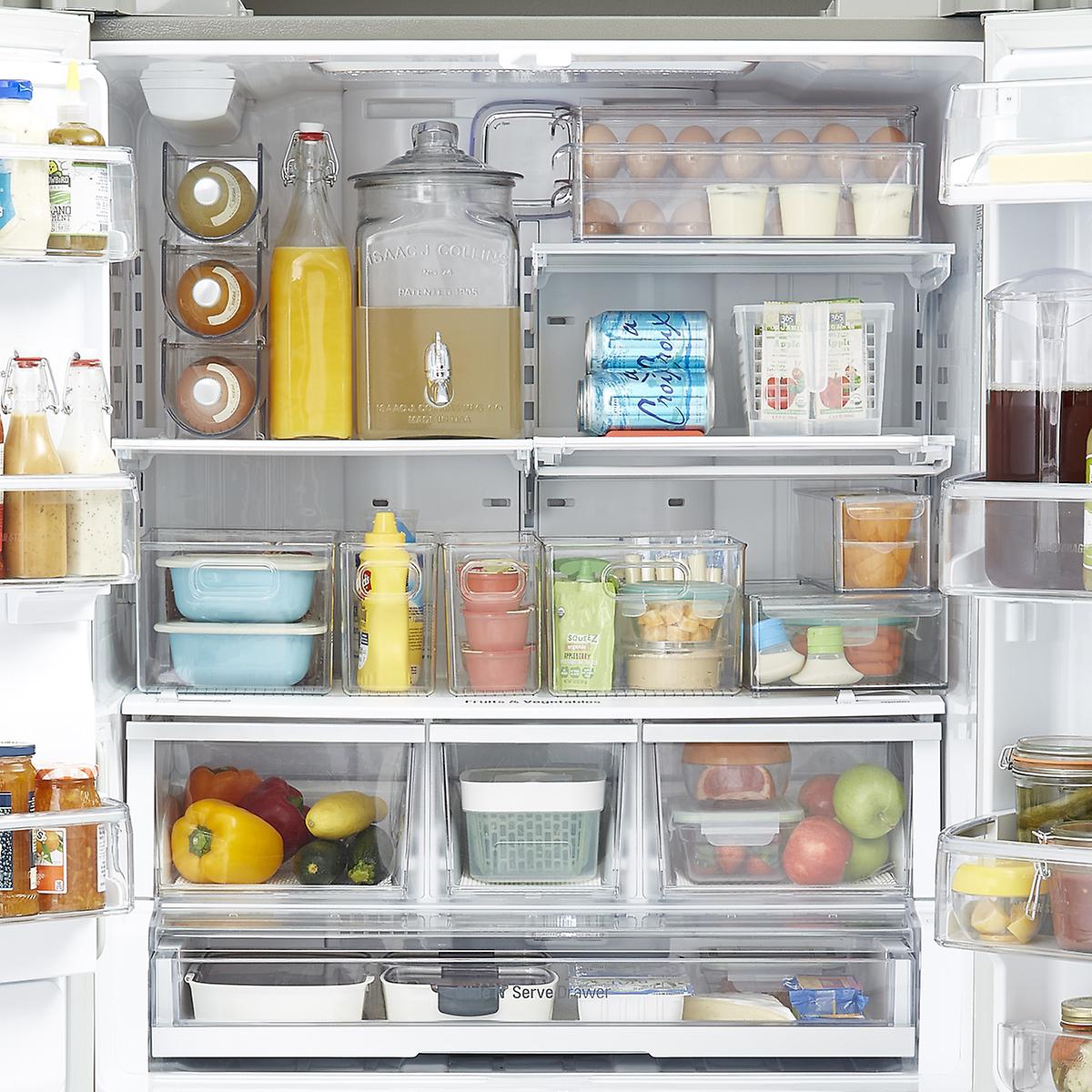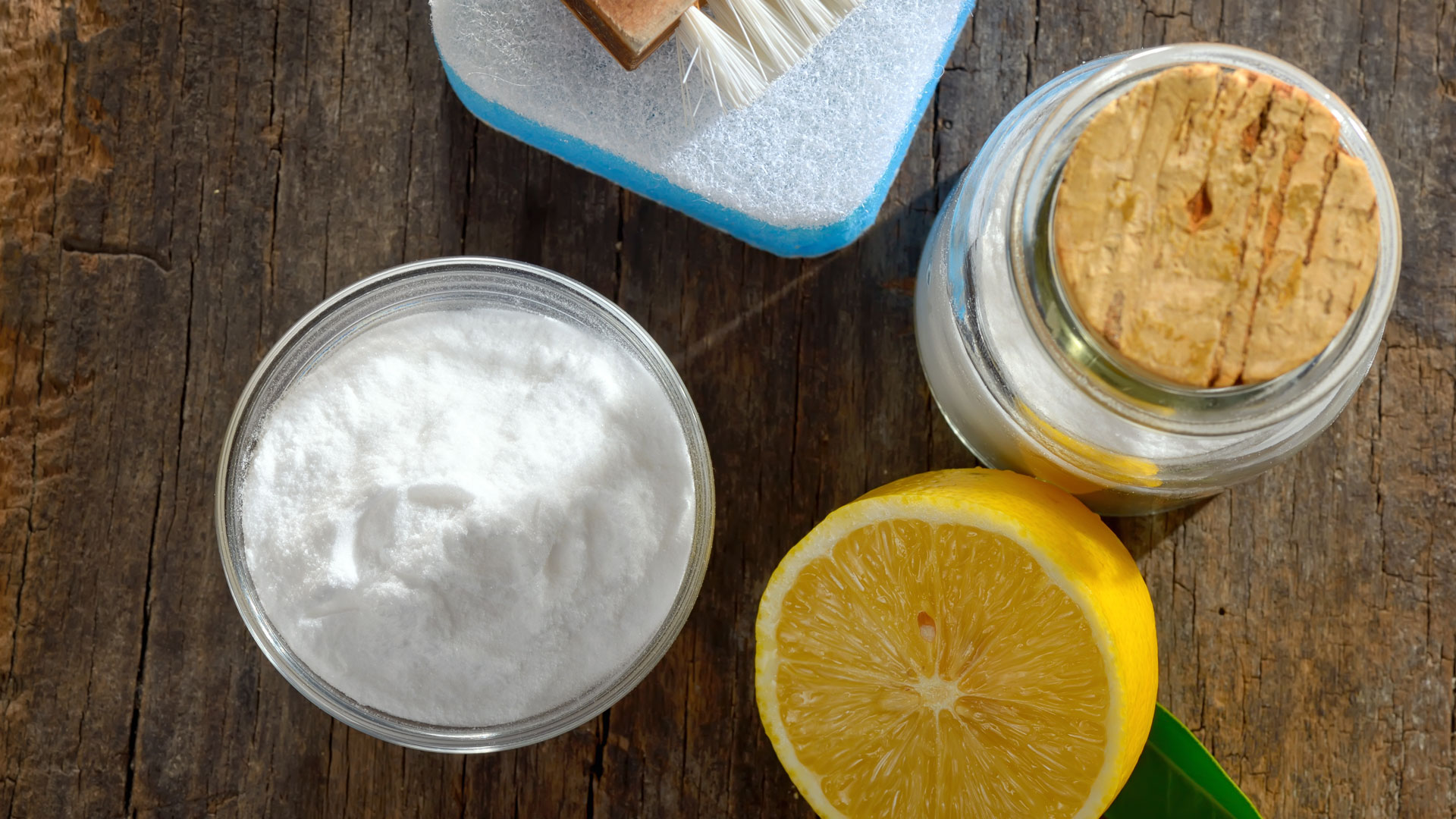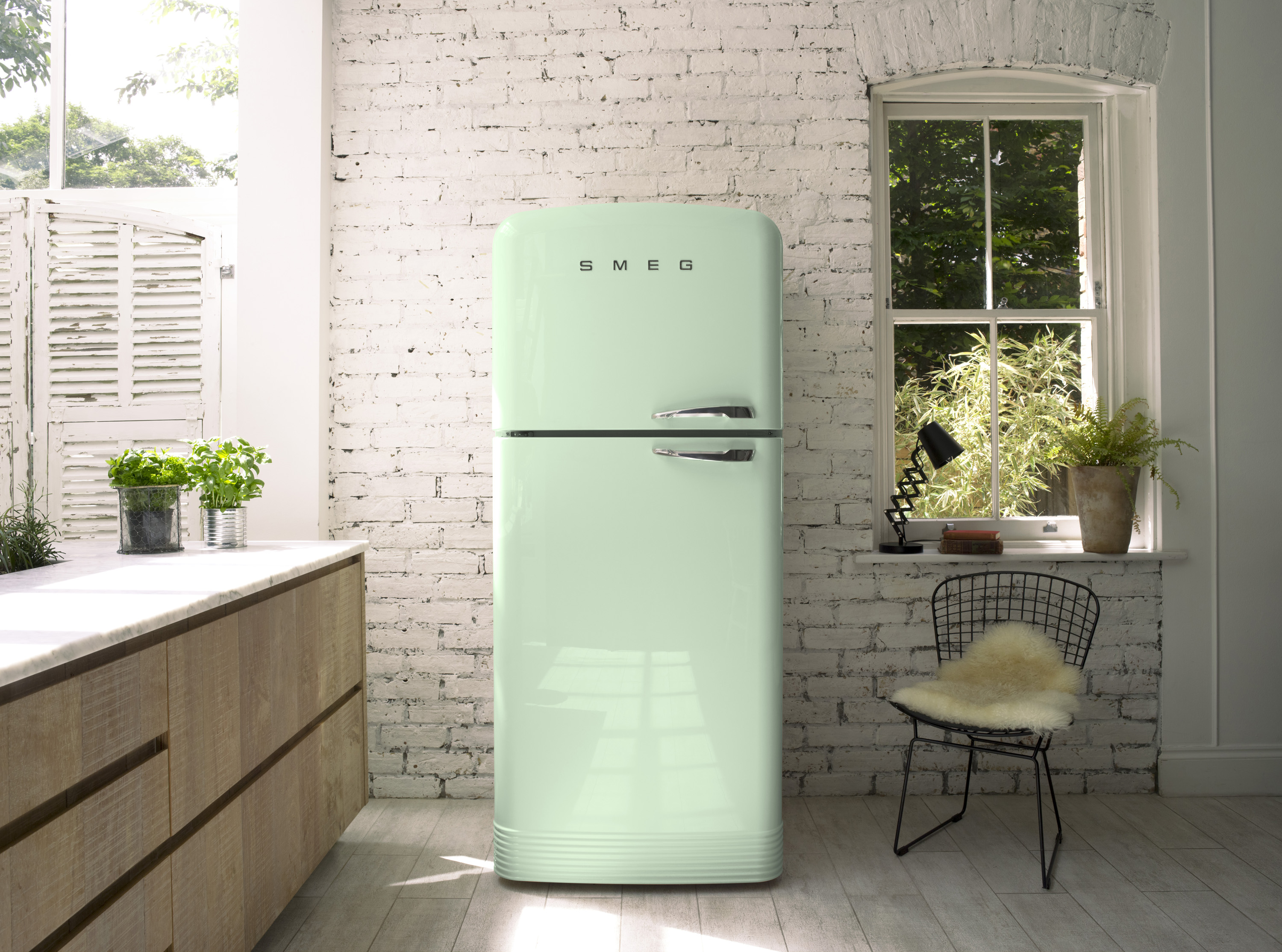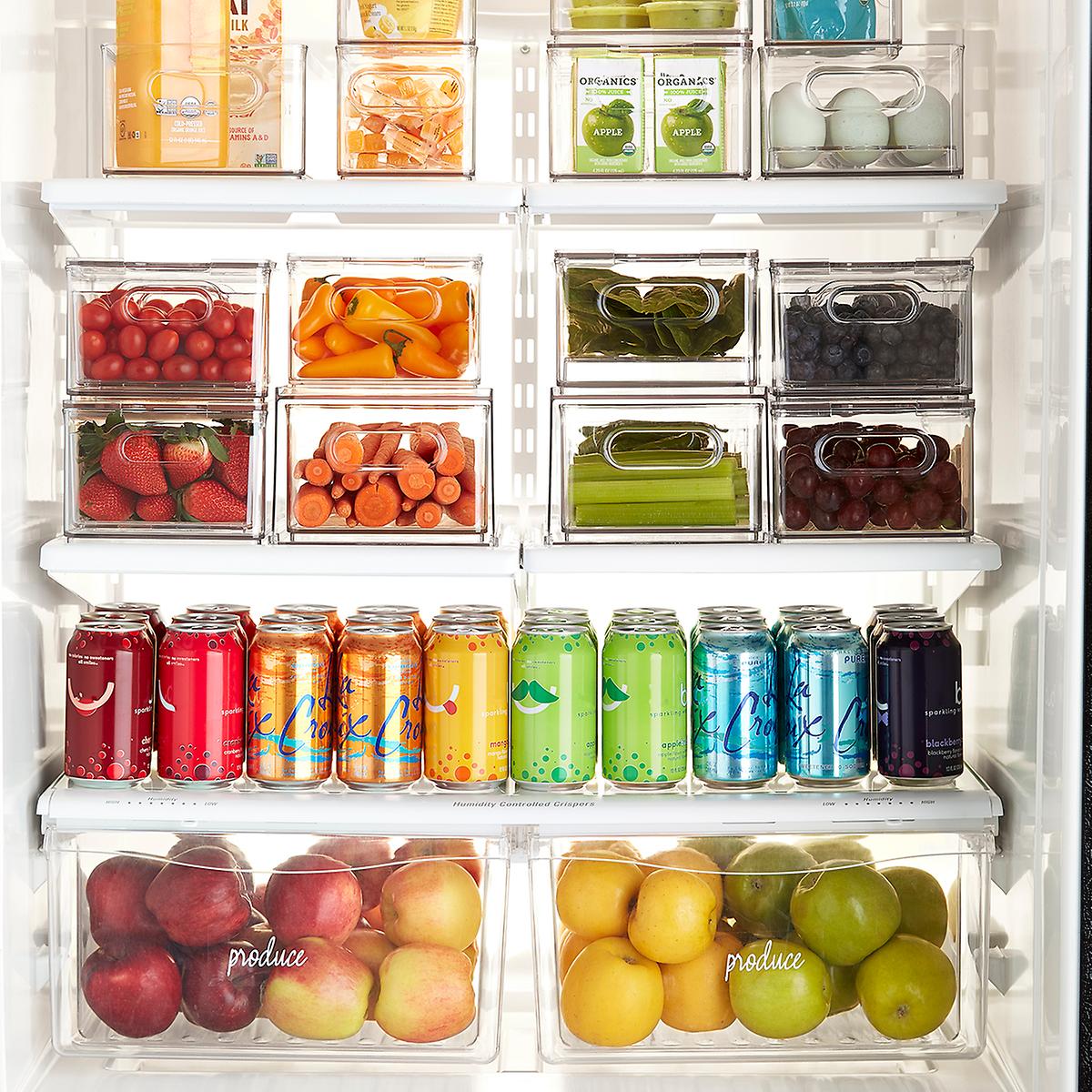How To Clean The Inside Of The Fridge
A refrigerator is one of those (much loved) large appliances that is so easy to assume clean on the inside when the exterior isn't so bad... However, if you need to know how to clean a fridge then you may have noticed those jars sticking to the glass shelves, a bit of a whiff and other telltale signs that your fridge is actually a little grimy and in need of attention.
After all, you chose the best fridge freezer to store your family's food and drink in so it should be one of the cleanest places in the house. It's only natural that spills, super tardy expiry dates and funky odors happen, but no one wants to eat from that kind of environment, so deep cleaning yours every once in a while is key.
What is the best thing to clean the inside of a fridge with?
We spoke with the experts in household appliances, Smeg about the best cleaning agents to use and how to go about cleaning a refrigerator. Like many experts in the field, they recommend: 'Straightforward hot soapy water will give your fridge a good clean but it's essential to make sure the shelves are properly dried. To give it a good refresh, ensure the condensate channel on the back wall of the fridge is also cleaned. Drinking straws, cocktail sticks and cotton buds are all great for doing so.'
In addition to dish soap and water, you can use baking soda and vinegar – as we'll explain below – as a means of cleaning and sanitzing your fridge naturally. It's best to avoid any strong cleaning products as you won't want any residual chemical particles and odors near your food and drink.
- Clean your entire kitchen space with our guide to quick and efficient kitchen cleaning like a professional.
How to deep clean a fridge – 10 steps

(Image credit: The Container Store)
1. Empty the fridge and edit its contents
We'd love to say that it's okay to simply empty the contents of the fridge on to the kitchen countertops before cleaning, but it's way wiser to a) check use-by dates and bin anything that's expired, b) wipe the underside of sticky bottles and jars before you transfer them and c) put meat and dairy products in a cool bag with freezer blocks, especially if it's a hot day (bacteria will multiply speedily at room temperature). Melissa Maker author of Clean My Space likes to be eco conscious also during this process, and rather than completely unplugging the fridge 'What I actually did was I turned off the cooling mechanism so that I wasn't wasting electricity during the cleaning process.'
Timing your fridge cleaning for before your shopping delivery will make your life easier; similarly, you'll want a freezer you're about to defrost to be as empty as possible before considering the clean up.
2. Take out the shelves and fittings... then wait
How many times have you cracked a plastic shelf trying to remove it from the fridge? Put simply, if you unplug or switch off the fridge and let the plastic come to room temperature before you remove it, it's less likely to split.
And if you do safely remove glass or plastic shelves or drawers from the cold fridge and immediately put them into hot water, it's possible they'll crack in the bowl. So, letting them come to room temperature (you can work on the fridge's interior while you wait), then putting them into hot soapy water to let them soak is worth the wait.
3. Clean the inside of the fridge
How to clean a fridge with vinegar
With the shelves and drawers out, spray the fridge's interior with a solution of distilled vinegar and water, concentrating on any areas with dried on gunk. Leave it to soak while you wash the shelves you removed earlier. Then return to the fridge and wipe it out thoroughly with a soft, damp cloth (rinse and squeeze it out regularly). The vinegar and water should work like magic at removing not just sticky mess and germs, but fridge smells, too (more on that later).
Always dry the fridge thoroughly before you put the food back in and shut the door.
How to clean a fridge with baking soda
As we said above, chemical products can leave behind smells that will be absorbed by your food, which makes natural cleaning products, such as baking or bicarbonate of soda, a much better choice – especially as cleaning with baking soda will see off nasty fridge smells at the same time.
For a fridge that's not too dirty, simply wipe a paste made of hot water and bicarbonate of soda to the fridge's interior with a soft, damp cloth, then rinse off with a clean cloth and dry with kitchen roll.
For caked on food, leave the wet paste to soak in for 10 minutes or so, then wipe off once it's softened.

(Image credit: shutterstock)
4. Clean your fridge's drain hole
Even if your fridge is working fine and with no pools of water (see below) it's still good to include this as part of your deep clean. Start by removing the vegetable drawers from the fridge, then simply use a drain hole cleaning device (it's like a mini plumbing snake) to work out the blockage.
If whatever was clogging up the hole has been there for a while, it's likely that there's mold and mildew at the back of the fridge, which you can get rid of by using a basting syringe to pour a small amount of vinegar and water into the drain hole.
Assuming you've removed as much of the gunk as possible with the drain hole cleaning device, use a cotton wool bud to work the vinegar/water solution around the hole to remove any remaining deposits.
Use the vinegar and water to wipe the bottom of the fridge out before returning the vegetable drawers. Keep the drain cleaning device somewhere handy (top shelf of the fridge); that way, you can tackle the drain hole every couple of months to keep the fridge running healthily.
- Got mold in other areas of your home? Read our advice on how to get rid of mold and mildew.
5. Clean the fridge drawers
Where it comes to fridge drawers, you won't be able to clean the properly unless you take them out completely. Pulling them out and wiping them won't allow you to get at the grime that collects in the corners, and there will be grime there, especially if you store vegetables without packaging.
Take out and empty the drawers, then soak them in warm soapy water. Scrub the insides with a bottle brush or old toothbrush. Rinse, pat dry and replace. If you're running out of counter space or are worried about forgetting where everything goes in your refrigerator – easily done – wash, dry and replace one basket or drawer at time.
6. Clean the fridge shelves (carefully)
So, you've removed the shelves and let them come to room temperature before putting them in hot, soapy water. You've given them a good clean... but there are still bits of hard-to-reach gunk between the surface of the shelf and the shelf surround. Our best cleaning tool? The toothpick. Simply run it along the joins in the shelf then wipe away whatever it collects.
That cotton bud you were using earlier for the drain hole? It's handy for getting food out of grooves in the fridge's interior, too. As is an old toothbrush.
And if you want to avoid cleaning your shelves, drawers and fridge bins in soapy water, swap it out for a couple of tablespoons of bicarbonate of soda in warm water.
What not to do? Put the fridge's fittings into the dishwasher: the water is too hot, especially for the plastic.
7. Wipe down the fridge seals
Fridge door seals, otherwise know as the gasket, can quickly collect crumbs and spills, so it's worth vacuuming into them with a crevice tool or working at them with a stiff washing up brush/ cleaning toothbrush every time you're cleaning the kitchen floor.
Then take a soft cloth, wrap it around a blunt knife, dip it in that vinegar/water solution, and run it gently along the crevices in the seals to collect the gunk. Use a fresh, dry cloth or kitchen towel to repeat the process – this should ensure the crevices are hygienically dry before you shut the fridge door again.
8. Clean the freezer compartment
If you've come this far, you may as well go all the way. First things first: place a towel at the bottom of the freezer to absorb any water that spills when you defrost it.
Switch the freezer off at the mains, then empty it, stashing any food into a freezer bag to keep it frozen. Shelves and trays should be allowed to come to room temperature before you stick them in warm water to avoid cracking (more on that, above).
Leave the door open for a few minutes to allow the ice to start melting – you could be tackling the fridge now if you're going for time-efficiency. Then use a freezer defroster ice shovel (yup, that's a thing, and you'll wish you had one if you've started without) to remove the biggest chunks of ice, being careful of the freezer's lining.
Next fill a spray container with equal parts of warm water and distilled vinegar and spray the freezer walls. Use a soft cloth to work the water/vinegar mix into the surfaces, then dry thoroughly.
You can help your freezer function at its best by not overloading it; by storing food evenly within it so that air circulates properly; and by ensuring food is properly covered or in an airtight container when it goes in. Wiping up fresh ice tray spills will help keep it ice free.
9. Allow the fridge and freezer to cool, then restock
With the fridge washed and thoroughly dried, shut the door (switch the temperature regulator back on if you need to) and wait for the temperature to reach 4°C or below before replacing the food. Use your fridge's fast-cool function if it has one to speed up the cooling process. Similarly, check the freezer is back to -18ºC before you put the food back in.
10. Finally, clean the outside of your fridge
Just as you used soapy water or baking/bicarbonate of soda inside the fridge, you can use both on the outside of a white appliance, too. Simply wet a soft cloth, pour on the soda and you're good to go. Remember to clean the top of the appliance's doors, since those can become sticky, and pay attention to the areas around handles, which become grimy with constant contact.
- Cleaning stainless steel? Work with the grain using the right product then check out how to clean stainless steel properly.

(Image credit: Smeg)
How to clean a fridge that smells
The first thing to do if your fridge smells is to check for food that's gone off, and ensure the fridge's temperature is correct (you can buy fridge thermometers if yours doesn't have one; your fridge should be at or below 4°C, and the freezer at -18° C). Neither applies? Clean the fridge thoroughly, including the drainage channel (more on this, below).
You can use vinegar or bicarbonate of soda to clean the fridge, but if you don't have those handy, try the following:
Ground coffee, spread on a tray and left in the fridge will soak up any bad fridge smells after a couple of days.
Activated charcoal will work like the coffee does.
Porridge oats: same technique, leave it for a couple of days then bin.
Vanilla-soaked cotton wool: got some vanilla extract in your baking drawer? It'll keep your fridge sweet-smelling.
Lemon halves, placed face down on a shelf will work at making your fridge smell citrusy.
Orange peel: same story.
Airtight food containers: these will keep food and its smells properly contained.
Why does a fridge have water at the bottom?
Condensation naturally builds up in a fridge, and it should be collected into the drain hole at the back of the fridge (it's usually about the height of the lowest shelf). There, it will go into an evaporation pan where it will... evaporate.
However, if your drain hole has become blocked by food, it's likely that all that condensation will end up at collecting as pools of water at the bottom of the fridge, and often inside your vegetable drawer. First thing to do is to check for obvious blockages. If that doesn't work, you'll need to clean your fridge's drain hole as above.
What to do with your fridge when you go away
Going on a prolonged holiday? The best thing to do – if you don't want to return to a fridge of moldy food – is to remove anything that's at risk of going off, and freeze it if possible. Better still, if your home is prone to power cuts, eat it before you go.
If you're going to be away for a really long time, it's best to empty the fridge completely, switch it off, clean it and leave its door open.
Then, just get your online grocery shop lined up for your return and you'll thank past self for being so organised.
How to deodorize a refrigerator between cleans
Depending on what kinds of food you store in your fridge, even a regularly cleaned one can be a bit whiffy. Cheese, garlic, and other strong-smelling foods are often responsible for an unpleasant smell in the fridge, even when the food is in good condition. Storing smelly foods in airtight containers is a good way to ensure your fridge doesn't smell, but another option is placing a cup filled with baking soda inside your fridge (you might need you on each shelf for larger fridges). Baking soda absorbs strong smells and prevents them from lingering inside the appliance.

(Image credit: The Home Edit / The Container Store)
Expert tips
A few final fridge cleaning tips from the pros. Maker mentions, 'It's important you dry everything really well because you don't want any excess moisture going into the fridge after you've cleaned it'.
Mrs Hinch shares, 'For a quick clean I fill the large drawer with warm soapy water and use this to wipe out the fridge! I'll soak the shelves and liners in the sink.'
How To Clean The Inside Of The Fridge
Source: https://www.realhomes.com/advice/best-ways-to-clean-a-fridge
Posted by: mcclanahanlitend1940.blogspot.com

0 Response to "How To Clean The Inside Of The Fridge"
Post a Comment